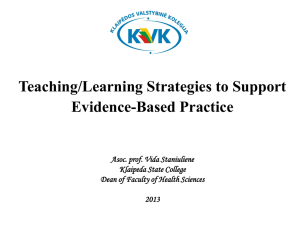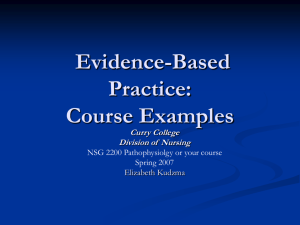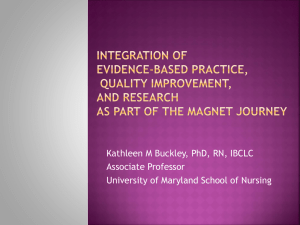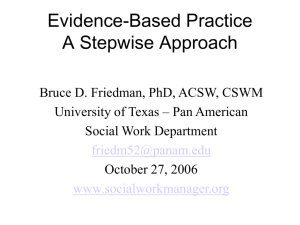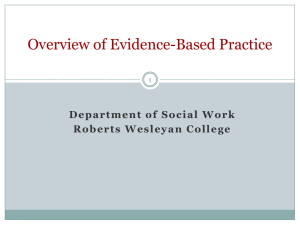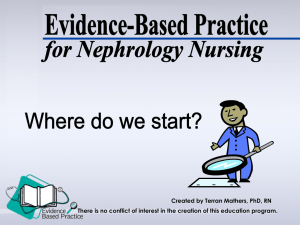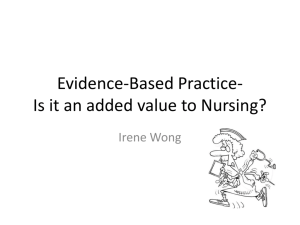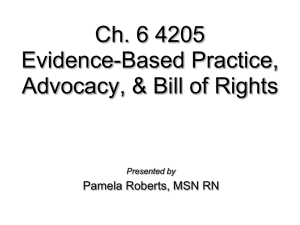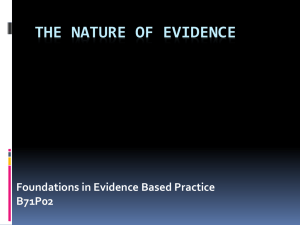Improving Care Through Research, Evidenced
advertisement
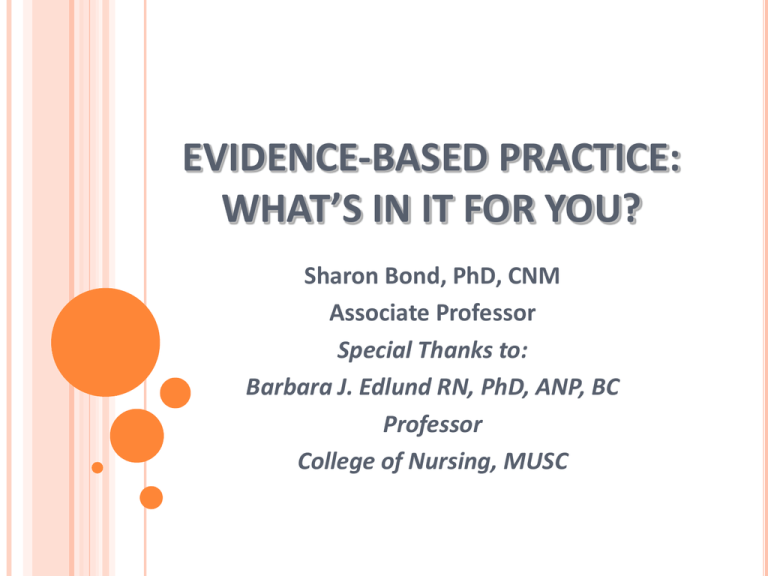
EVIDENCE-BASED PRACTICE: WHAT’S IN IT FOR YOU? Sharon Bond, PhD, CNM Associate Professor Special Thanks to: Barbara J. Edlund RN, PhD, ANP, BC Professor College of Nursing, MUSC SO MANY QUESTIONS . . . Evidence-Based Practice (EBP): What is the best approach for managing neuropathic pain in the terminally ill patient? What research has been done that could provide clinical practice guidelines? Quality Improvement (QI): Are we doing the right things to appropriately manage patients’ neuropathic pain? How do we know? How are we measuring patient outcomes? Research (R): What is it like to live with neuropathic pain?Does drug “A” work better than drug “B?” What’s been studied? Where are the gaps? COMMONALITIES – PROVIDE STRUCTURE! Evidence-based practice (EBP) – utilizes the best clinical evidence in making patient care decisions typically from research. EBP translates knowledge into practice Quality improvement (QI) - utilizes a system to monitor and evaluate the quality and appropriateness of care (outcomes) based on EBP and research Research (R) - applies a methodology whether quantitative or qualitative to develop, uncover, create, find, add new nursing knowledge COMMONALITIES – IMPROVE CARE DELIVERY! Involve teamwork – not done in isolation Call for critical thinking and creativity Commitment to improve care One informs the other Nurses base their practice on emerging evidence from research (EBP) Research starts in practice and ends in practice Quality improvement evaluates and monitors care, and identifies opportunities to improve care as the processes and outcomes of care are measured, continuously evaluated and improved WHAT IS EVIDENCE-BASED PRACTICE? Conscientious use of current best evidence to make decisions about patient care A problem-solving approach to clinical practice Based on: 1. systematic search for and appraisal of most relevant evidence to answer questions 2. one’s clinical experience and expertise 3. patient preference and values LEVELS OF EVIDENCE I II III IV V VI VII Evidence - Systematic reviews, meta-analysis RCTs, EB clinical practice guidelines based on RCTs Evidence - One well designed RCT Evidence - CTs without randomization Evidence - Well-designed case control or cohort studies Evidence - Systematic reviews of descriptive or qualitative studies Evidence - Single descriptive or qualitative study Evidence – Opinions of authorities, reports of experts EVIDENCE-BASED PRACTICE The process of doing the “right thing” Standards of care Baseline description of quality- may be discipline focused AANP standards of NP practice Clinical guidelines Broad-based recommendations Critical pathways Identify key/critical activities that must occur in predictable fashion Protocols Detailed procedures on how to proceed with evaluation and treatment NONPF FIVE STEPS OF EVIDENCE-BASED PRACTICE Ask the burning clinical question (Picot format) Search for and collect the most relevant and best evidence Critically appraise the evidence Integrate all evidence with one’s clinical expertise, patient preferences and values in making a practice decision or change Evaluate the practice decision or change (Disseminate) Unlike research utilization (info from a single study), EBP - takes into account expertise of the practitioner and patient preferences / values Melnyk & Fineout-Overholt 2005 STAR MODEL – FIVE STAGES: EBP Depicts 5 major stages of knowledge in a relative sequence as research evidence is moved through several cycles, combined with other knowledge and integrated into practice Converting knowledge into practice Provides a framework for systematically putting evidencebased practice processes into operation Stevens 2004 (www.acestar.uthscsa.edu) Reference: Haynes (1998). Barriers and bridges to evidence-based clinical practice. BMJ, 317:273-276. QUALITY IMPROVEMENT Process that utilizes a system to monitor and evaluate the quality and appropriateness of care based on evidence-based practice and research ASPECTS OF QUALITY IMPROVEMENT On-going process to improve quality of care Whole team collaborates across departments and systems…team with clear aims, clear outcome measures of results to be achieved…process for implementing change and institutional or organizational support Information systems…show me the data System focused (not individual) Practice process changes to meet guidelines (EBP) and to see if changes are working NONPF QUALITY IMPROVEMENT: FOCUS Questions (3) 1. What are we trying to accomplish? 2. How will we know a change is an improvement? 3. What changes can we make that will result in improvement? Rapid Improvement or PDSA cycles PDSA: THE DEMING MODEL Plan - Test objectives - Who will do what - Predict outcomes Do - What happened - Did it work Study - Analyze outcomes in context of predicted - Summarize lessons learned Act - What modification needs to be made - Statement of new plan ….. PDSA cycle repeats NATIONAL GUIDELINES OR BENCHMARKS Need quantifiable measures Need to know the difference between your practice and national benchmarks National Guidelines Clearing House Guidelines.gov National benchmarks or quality goals…AHRQ NONPF BARRIERS TO EVIDENCE-BASED PRACTICE Overwhelming patient workloads Misperceptions about EBP and research Lack of time and resources to search for and appraise evidence Organizational constraints – lack of support Peer pressure to continue with practices that are steeped in tradition – “we’ve always done it this way and we are not changing now” Melnyk & Fineout-Overholt 2005 BARRIERS TO EVIDENCE-BASED PRACTICE Knowledge… lack of knowledge/awareness .… unfamiliar with guidelines and guideline accessibility Attitudes …. lack of confidence in the guideline developer, lack of motivation to perform the guideline recommendations Behaviors …. inability to incorporate patient preferences into the clinical decision making process Melnyk & Fineout-Overholt 2005 WHAT ARE YOUR EXPERIENCES WITH CHANGE? Have you ever tried to change a practice at your work site? What worked? What didn’t? What was the final outcome? What would you do differently? Do facts (evidence) change behavior? RESEARCH: WHEN EVIDENCE IS NOT THERE/NOT SUFFICIENT Conduct a research study to determine the “what is it we want to know” Nature of the question will determine the level of the research study 1 - What is the nature of the phenomenon? 2 - Who, what, how many, how much? 3 - What are the relationships among the variables? 4 - Does one variable cause the other? RESEARCH QUESTIONS….. First three questions - reflect levels of research seeking descriptive knowledge of the variables under study…non-experimental design Fourth question reflects a level of research that examines cause and effect…experimental design Before one conducts an experimental research study, one must have data from the three previous levels to support such a study…the preliminary work! Value of research…adds new knowledge…to guide and improve nursing practice QI VS. RESEARCH Intervention may be multifactorial represents best practices Rapid improvement cycles No risk to patients Audience is organization Data source: organization Design - no controls Not generalizable NONPF Untried intervention being tested Risk may be present Complex protocol Audience is scientific community Data source –randomized population, multiple sites Design – focus on controls Generalizable HOW DOES FOCUS OF DNP DIFFER FROM PHD? DNP: Experts in EBP PhD: Experts in Research Eating during labor Identify the problem Find the evidence Appraise the evidence Integrate evidence with clinical expertise, patient values Evaluate outcomes Disseminate Eating during labor Explore, compare cultural differences Compare differences in practice by geographic region, type of hospital, birth center Physiologic effects of restriction QUALITY IMPROVEMENT (QI) VS. PERFORMANCE IMPROVEMENT (PI) Often used interchangeably Useful to think of PI as a “drill down process” to look at a specific problem that occurs with the implementation of EBP OTHER THOUGHTS…. Research, quality improvement and evidence based practice are integral to the delivery of quality patient care Each informs the other and improves upon the other Each requires commitment, team work, vision, critical thinking, creativity, leadership, energy and endurance “Doing the right thing” in each of these areas contributes to an environment of excellence, quality patient care and clinician satisfaction…and sets you apart as an organization! YOUR DNP PRACTICE INQUIRY PROJECTS What are your burning issues in health care, in your advanced nursing practice (why are you here)? Implement innovations Apply evidence-based interventions Propose changes to care delivery models Implement quality improvement projects Develop and implement health policy You are a Change Agent ! REFERENCES Burns & Grove (2005). The Practice of Nursing Research (5th ed).St. Louis: Elsevier Saunders Polit & Beck (2008). Nursing Research: Generating and Assessing Evidence for Nursing Practice. Philadelphia : Lippincott Williams & Wilkins Melnyk & Fine-Overholt (2005). Evidence-Based Practice in Nursing & Health Care. Philadelphia: Lippincott Williams & Wilkins Roberts & Bourke (1989). Nursing Research: A Quantitative and Qualitative Approach. Boston: Jones & Bartlett NONPF ACE Star Model: http://www.acestar.uthscsa.edu/Learn_model.htm Deming Model: http://www.ihi.org/IHI/Topics/Improvement/ImprovementMethods/HowToImprove/
